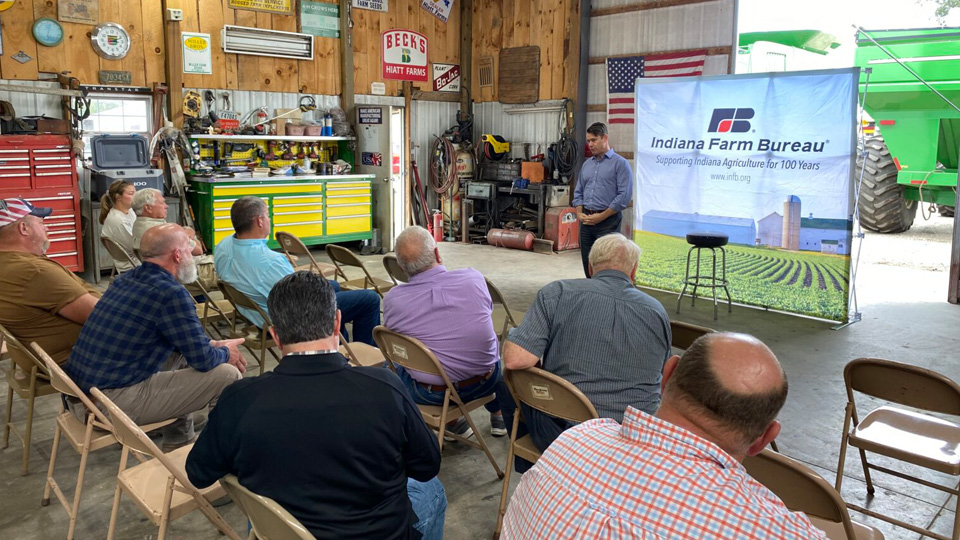Indiana Farm Bureau outlines priorities for farm bill
Subscriber Benefit
As a subscriber you can listen to articles at work, in the car, or while you work out. Subscribe Now
Indiana’s largest farmer advocacy group says it’s prioritizing commodities, conservation and nutrition in its lobbying efforts around the next federal farm bill.
Indiana Farm Bureau, an agricultural organization that seeks to support Hoosier farmers, made the announcement after members of Indiana’s congressional delegation spent time during their recent six-week recess to meet with the state’s farm bill task force to discuss the next round of agricultural legislation on Capitol Hill.
That included visits from Republican Sens. Todd Young and Mike Braun, Republican Rep. Larry Bucshon, and Democratic Rep. Frank J. Mrvan.
The task force, made up of farmers and agricultural professionals from around Indiana, convened in January. Since then, the group has reviewed current farm bill policy, heard from industry experts, and discussed each of the eight main focus areas, or “titles,” of the current farm bill to come up with recommendations for Indiana Farm Bureau to prioritize.
What Indiana farmers want most in new legislation
Indiana Farm Bureau representatives said the organization supports additional, new base acres under certain circumstances. Base acres reflect a farm’s historical plantings and have a program commodity assigned to each base acre.
Under current law, determining a farm’s federal program payment is based on old base acreage data. As a result, many farms today actually plant more acres than what they have in total base acres. An update to those base acres would change the distribution of farm program payments, which could mean more money for farmers.
Indiana Farm Bureau noted that many small tracts of land in the state are coming back into production that previously were pastures, tobacco or hay fields, or used for other purposes. Now those areas are being used to plant program crops.
The organization said it also recommends that any climate change initiatives proposed in the farm bill should not be a prerequisite for any other U.S. Department of Agriculture (USDA) conservation or crop insurance program. Farmers who spoke at task force meetings earlier this year emphasized that climate change initiatives should instead be voluntary and incentive based.
Despite “some concern with inflation,” the nutrition-focused title of the farm bill — which authorizes a number of nutrition and domestic food assistance programs — is “just as important and beneficial to farmers and ranchers and should be included” in the new legislation, according to Indiana Farm Bureau officials.
The policy recommendations will be presented for consideration at the American Farm Bureau Federation’s national convention in January.
“Indiana Farm Bureau has always tried to take a proactive role in helping shape legislation that affects farmers,” Randy Kron, president of the Indiana Farm Bureau, said in a news release. “Agriculture is made up of so many diverse interests, and it is important that Hoosier farmers and midwestern commodities find their voice in federal policy discussions.”
The current U.S. farm bill — the Agriculture Improvement Act of 2018 — is set to expire next year. Congress updates the legislation every five years.
With the outcomes of November’s midterm elections still undecided, that means the next bill draft could be debated under new congressional leadership.
“Writing a farm bill is a long, complex process that is influenced by many different forces,” Kron said. “The Senate and House agriculture committees, state and national agriculture groups, environmental groups, nutrition groups and others all participate in the process.”
Bleak outlook among farmers
Harvest projections across Indiana are positive this season, thanks in part to cool and dry weather conditions that have helped with fieldwork. Indiana’s corn harvest for this season is 16% complete, according to the USDA. So far, 17% of soybeans have been harvested.
But farmer’s outlooks on the economy are on the decline, according to economists at Purdue University’s Center for Commercial Agriculture.
Results from a nationwide survey released Monday showed a growing number of producers are increasingly concerned about the impacts of rising interest rates on their farm operations. The report indicated that 44% of farmers say higher input costs remain their number one concern.
When asked to look ahead to 2023, 38% of producers said they expect input prices to rise from 1% to 9% compared to 2022 prices. Another 10% of farmers who responded to the survey said they think prices could be 20% higher next year.
“Rising input prices are a major concern for our members. We’ll work to see if we can find innovative ways to work with both our federal and state lawmakers to find opportunities to reduce input prices,” said Andy Tauer, executive director of public policy at Indiana Farm Bureau. “This is an issue that is very important to our members as input costs play directly into long term farm sustainability as well as our ability to bring the next generation back to the farm.”
In addition to issues that will be addressed in the federal legislation, Tauer told the Indiana Capital Chronicle that Indiana Farm Bureau will focus on other issues affecting Hoosier farmers, too, once the Indiana Legislature reconvenes in January. Those specific priorities are expected to be released in the coming months.
“As we look toward the upcoming legislative session, rural broadband is something that many of our members continue to discuss. We’ll work with state leaders and continue to advocate and share the need for high quality broadband in rural Indiana,” Tauer said. “As members deploy more advanced technology on their farms and businesses, it just re-enforces the need for further expansion of broadband.”
The Indiana Capital Chronicle is an independent, not-for-profit news organization that covers state government, policy and elections.
